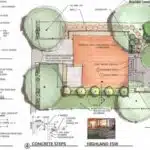As landscape designers, we are often tasked with creating spaces that not only look beautiful but also serve a purpose. One way to achieve this is by designing a rain garden. Rain gardens are not only aesthetically pleasing, but they also provide numerous environmental benefits.
A rain garden is a shallow depression in the ground that is designed to capture and store rainwater runoff. It is typically planted with native vegetation and allows the water to slowly infiltrate into the ground instead of flowing into storm drains and ultimately polluting our waterways. By designing a rain garden, you can help reduce flooding, improve water quality, provide habitat for wildlife, and even save money on your water bill. In this article, we will discuss how to design a rain garden that not only looks beautiful but also serves as an ecological asset to your community.
Understanding The Benefits Of Rain Gardens
As the old adage goes, “April showers bring May flowers.” But with climate change bringing more extreme weather patterns, it’s becoming increasingly important to manage the excess water that comes with those April showers. This is where rain gardens come in. Rain gardens are a sustainable solution to managing excess rainwater while providing numerous environmental benefits.
Rain garden case studies have shown that these gardens can help prevent flooding by absorbing and filtering excess water, reducing runoff and erosion. Additionally, they can improve water quality by filtering pollutants such as fertilizers and pesticides from runoff before it enters rivers or lakes. Rain gardens also provide habitat for wildlife such as birds, butterflies, and bees, which contribute to the health of our ecosystems.
Despite their many benefits, designing a rain garden can present challenges. Factors such as soil type, slope of the site, and available space must be taken into consideration when creating a design that is both functional and aesthetically pleasing. However, with proper planning and implementation techniques, these challenges can be overcome to create a beautiful addition to any landscape that serves both aesthetic and environmental purposes.
Moving forward with designing your own rain garden requires assessing your site for its suitability. By taking into account factors like the amount of rainfall your area receives annually and the type of soil present on your property will help you determine whether or not a rain garden is right for you.
Assessing Your Site For A Rain Garden
- Identifying drainage patterns is an important part of assessing the site for a rain garden. It helps to assess the flow of water on the site and helps to determine the best location for the rain garden.
- Evaluating soil type is also important for assessing the site for a rain garden. Different soil types have different drainage capabilities and can affect the installation and effectiveness of the rain garden.
- Soil evaluation can be done by taking soil samples and testing them to determine the type of soil present on the site.
- Once the drainage pattern and soil type have been identified, the landscape designer can create a plan to install the rain garden in the best location for optimal performance.
Identifying Drainage Patterns
Identifying drainage patterns is crucial in designing a successful rain garden. It involves analyzing the soil conditions and slope of the site to determine where water naturally flows and collects. Soil with high clay content can cause poor drainage, while areas with sandy or loamy soils are ideal for infiltration.
A slope analysis is also necessary to identify areas where water may accumulate and cause erosion or runoff. Ideally, a rain garden should be situated at the lowest point of the site where water naturally collects. Additionally, it’s important to avoid placing rain gardens near building foundations or septic systems.
By identifying drainage patterns, landscape designers can create a rain garden that will effectively manage stormwater runoff while providing aesthetic value to the site. Proper planning ensures that rainwater is directed away from buildings and infrastructure while also allowing it to infiltrate into the ground, improving soil quality and reducing erosion. With careful consideration of these factors, a well-designed rain garden can provide both functional and environmental benefits to your property.
Evaluating Soil Type
Assessing drainage patterns is just the first step in designing a successful rain garden. To create an effective and sustainable rain garden, we must evaluate the soil composition of the site. Soil type plays a crucial role in how well water is absorbed and filtered through the ground. For this reason, landscape designers need to understand how to assess soil types accurately.
Soil composition can be determined through a series of tests, including texture analysis and chemical testing. By understanding the soil’s characteristics, we can determine its ability to absorb and store water. Proper evaluation can also help us identify areas where water may collect or drain too quickly, which affects plant growth and infiltration rates.
In conclusion, evaluating soil type is essential for creating a functional and sustainable rain garden design. By assessing drainage patterns and analyzing soil composition, landscape designers can create an effective system that will manage stormwater runoff while enhancing the aesthetic value of your property. With proper planning, we can design a rain garden that not only serves its intended purpose but also promotes environmental health by reducing erosion and improving soil quality.
Determining The Size And Shape Of Your Rain Garden
The size and shape of your rain garden should be based on the amount of water that will be collected from your roof or other impervious surfaces. The location of your rain garden is also a crucial factor to consider in determining its size and shape. It is recommended that the rain garden is located at least 10 feet away from your home’s foundation to prevent water damage.
When designing the size and shape of your rain garden, it is essential to follow some basic design principles. The first principle is to make sure that the garden slopes gently towards the center, where you can place a depression or an overflow outlet. This will allow excess water to drain off quickly. The second principle is to ensure that the soil in your rain garden has good infiltration capacity so that it can absorb as much water as possible before it reaches the overflow outlet.
To make sure that you get the most out of your rain garden, here are some additional tips:
- Choose a site with plenty of sunlight
- Consider using native plants for greater sustainability
- Use a variety of plant species for year-round interest
- Avoid planting invasive species
- Plan for maintenance such as pruning and weeding
With these tips in mind, you can design a beautiful and functional rain garden that will benefit both your property and the environment.
Transition: Now that you have determined the size and shape of your rain garden, let’s move on to choosing the right plants for your space.
Choosing The Right Plants For Your Rain Garden
Like a painter selecting the right colors for their canvas, plant selection is a crucial step in designing a rain garden. The plants you choose will not only enhance the visual appeal of your garden but also help to filtrate pollutants and prevent erosion. When choosing plants, consider the amount of sunlight and water that your garden receives. Native plants are an excellent choice as they are adapted to local conditions and require less maintenance.
Maintenance tips for your rain garden include regular watering during dry spells, removing weeds promptly and pruning plants as needed. A layer of mulch around your plants can help retain moisture and suppress weed growth. Be sure to monitor your garden for any signs of erosion or standing water. If necessary, add more soil or adjust the depth of your garden to ensure proper drainage.
Understanding soil types and drainage is essential when designing a rain garden. Soil that drains too quickly may not provide enough moisture for your plants while soil that retains water can lead to standing water in your garden. Conducting a percolation test will help determine how well your soil drains and what amendments may be required. Planting species with different root depths can also improve drainage by breaking up compacted soil layers.
As you move onto understanding soil types and drainage, keep in mind that every aspect of designing a rain garden is interconnected, and each decision you make impacts the effectiveness of the overall design. By following these guidelines for plant selection and maintenance, you’ll be on track towards creating an aesthetically pleasing and environmentally friendly rain garden that serves its purpose effectively.
Understanding Soil Types And Drainage
Soil preparation and drainage solutions are crucial components to consider when designing a rain garden. Understanding your soil type is the first step in designing an effective rain garden that will thrive and serve its purpose. Soil types can be classified as clay, silt, sand, or loam. Clay soils have small particles that do not allow water to drain well, while sandy soils have larger particles and drain too quickly. Loamy soils are the best for rain gardens since they balance the right amount of drainage and moisture retention.
Once you have identified your soil type, preparing the soil is essential for successful plant growth and drainage. The ideal soil depth for a rain garden is between 2 to 3 feet deep, allowing enough space for plants to establish deep roots and for water infiltration. Soil amendments such as compost or organic matter can improve soil structure, increase nutrient levels, and promote microbial activity necessary for healthy plant growth.
Drainage solutions should also be incorporated into your rain garden design. Installing a perforated pipe or French drain at the bottom of your rain garden will help excess water drain away from your home’s foundation. Additionally, creating a berm around the perimeter of the garden will prevent water from flowing outwards towards sidewalks or other areas that do not require additional moisture.
Incorporating proper soil preparation techniques and drainage solutions into your rain garden design will ensure long-term success in serving its intended purpose of reducing stormwater runoff. Planning for maintenance and upkeep is also critical in ensuring your rain garden remains functional over time.
Planning For Maintenance And Upkeep
The long-term success of a rain garden depends on the proper planning for its maintenance and upkeep. Euphemistically speaking, it is important to view maintenance as an opportunity to nourish and cultivate the garden, rather than simply as a chore. Seasonal tasks such as removing debris, pruning plants, and replenishing mulch should be part of a regular maintenance routine to ensure that the garden functions optimally.
To maintain the health and vibrancy of your rain garden, it may be necessary to seek professional assistance. Landscape professionals can provide guidance on best practices for maintaining the garden’s health, including suggestions for fertilizing and controlling pests and diseases. Additionally, they can help with more complex tasks such as soil testing or redesigning parts of the garden that are not thriving.
In addition to these seasonal tasks and seeking professional assistance when needed, it is also important to monitor your rain garden regularly throughout the year. This includes checking for signs of erosion or runoff issues that may require attention. By staying vigilant about your garden’s needs and taking proactive steps when necessary, you can help ensure its long-term success. Next, we will discuss how calculating water needs and runoff is an essential step in designing an effective rain garden.
Calculating Water Needs And Runoff
Once you have planned for the maintenance and upkeep of your rain garden, it is time to move on to calculating the necessary water needs and runoff. A key component of designing a successful rain garden is understanding how much water it will need to sustain plant life and how much runoff it will be able to handle. Determining these factors requires careful consideration of the size and location of your garden, as well as the types of plants you plan to include.
The first step in calculating the water needs and runoff of your rain garden is to determine its size. This can be done by measuring the area where you plan to install the garden. Once you have determined the size, you can then estimate how much water will be needed based on the type of vegetation you want to grow. Different plants require different amounts of water, so it is important to do some research before selecting which species you want to include.
In addition to determining water needs, it is also important to calculate runoff. This involves assessing how much rainfall your garden will receive during a typical storm and how quickly that water will drain away from your property. By understanding these factors, you can design an effective drainage system that will prevent flooding and erosion, while also promoting healthy plant growth. In the next section, we will discuss how to install drainage and overflow systems that work seamlessly with your rain garden’s design.
Installing Drainage And Overflow Systems
Imagine a river flowing through your backyard. Placing rocks and logs strategically along the river’s banks slows down the water, preventing erosion and creating a diverse habitat for wildlife. This is the same concept behind installing drainage and overflow systems in your rain garden. The goal is to slow down and capture stormwater runoff, allowing it to percolate into the ground instead of overwhelming nearby bodies of water.
To start, consider the size and shape of your rain garden when designing your drainage system. You want to ensure that all areas of the garden receive adequate water without any areas becoming saturated or flooded. Installing an underdrain with a perforated pipe surrounded by gravel can help distribute water evenly throughout the garden. Additionally, an overflow system should be installed to prevent excess water from flooding surrounding areas during heavy rainfall events.
Rain garden maintenance is crucial for ensuring that your drainage system continues to function effectively over time. Regular cleaning of debris from gutters and downspouts will prevent clogs that lead to overflowing water during heavy rainfall events. It’s also important to regularly check on your drainage system and remove any sediment buildup that may reduce its effectiveness.
As you prepare to plant your rain garden, keep in mind how important proper drainage is for its success. With a well-designed drainage system in place, you can ensure that all areas of your garden receive adequate moisture while preventing flooding or oversaturation. In the next section, we’ll discuss how to best prepare your site for planting so that your rain garden can thrive for years to come.
Preparing The Site For Planting
Site preparation is one of the most crucial steps in designing a functional rain garden. The first step in preparing your site is to remove all existing vegetation and debris. This process will help create a clean slate for planting and ensure that your plants have access to adequate sunlight.
Once your site is clear, you should conduct a soil test. Soil testing will help determine the pH level of your soil and identify any nutrient deficiencies. It’s essential to amend your soil accordingly before planting, as healthy soil is critical for the success of your rain garden.
Additionally, you should consider how water flows through your site during heavy rains. Observe where water pools or runs off and identify any areas that need grading or slope adjustments. By preparing the site correctly, you’ll be able to create an optimal environment for plant growth and efficient water management.
With site preparation complete, it’s time to move on to planting and mulching your rain garden. By following these essential steps, you’ll be able to design a beautiful and functional rain garden that provides ecological benefits for years to come.
Planting And Mulching Your Rain Garden
When it comes to planting your rain garden, it is important to choose plants that can withstand both wet and dry conditions. Native plants are always a great choice as they are already adapted to the local climate and soil conditions. When selecting your plants, consider their size at maturity, color, bloom time, and growth habit. It’s best to plant taller species towards the back of the garden bed and shorter plants in the front.
Mulching techniques play an important role in maintaining healthy soil moisture levels in your rain garden. A layer of mulch can help retain moisture, suppress weed growth, regulate soil temperature, and add nutrients back into the soil as it decomposes. It’s best to use organic mulches such as shredded leaves or bark chips. Avoid using plastic or synthetic materials as they can prevent water from reaching the roots of your plants.
Plant selection criteria should also include consideration for how well each species can filter pollutants from stormwater runoff. Plants with deep root systems are especially helpful in capturing pollutants before they reach groundwater sources. Additionally, incorporating a mix of flowering perennials and grasses can attract pollinators and provide habitat for beneficial insects that help control pests.
As you move forward with designing your rain garden, keep in mind that proper planting and mulching techniques will be essential for ensuring long-term success. In our next section, we will explore watering and irrigation techniques that will help you maintain healthy plant growth throughout the year.
Watering And Irrigation Techniques
- Water conservation is a critical factor in any landscape design, and can be achieved in various ways such as drip irrigation and rainwater harvesting.
- Drip irrigation is a popular method in landscape design that conserves water by applying it directly to the soil, reducing the amount lost through evaporation and runoff.
- Rainwater harvesting is the practice of collecting rainwater from surfaces such as rooftops and storing it for later use.
- Rain gardens are another way to conserve water. They are designed to capture and store runoff from impervious surfaces for reuse.
- Designing a rain garden requires knowledge of the site’s hydrology, soil type, and vegetation to ensure the garden is effective at collecting and storing water.
- The garden’s size and shape must also be considered, as well as the potential for water to be diverted to other areas and the impact this will have on the existing environment.
Water Conservation
Rain gardens are a great way to conserve water while also adding beauty and functionality to your landscape design. By harvesting rainwater, you can reduce the amount of municipal water needed for irrigation. This not only saves money on your water bill but also helps to ensure that there is enough water available for everyone during times of drought or other water shortages.
When designing a rain garden, it’s important to choose plants that are drought resistant and can handle periods of heavy rainfall followed by dry spells. These plants will not only thrive in your rain garden but will also help to prevent erosion and filter pollutants from runoff water. Incorporating native plants into your design can also help attract pollinators and support local ecosystems.
In addition to choosing the right plants, the location and size of your rain garden are important considerations when it comes to water conservation. Placing your rain garden in an area that receives a lot of runoff from rooftops or paved areas can help capture more rainwater. Additionally, making sure the size of your rain garden is appropriate for the amount of precipitation in your area can ensure that you’re making the most efficient use of this natural resource. Overall, designing a rain garden is a great way to conserve water while also creating a beautiful and functional addition to your landscape design.
Drip Irrigation
To further maximize the efficiency of water usage in landscape design, another watering and irrigation technique that should be considered is drip irrigation. Drip irrigation is a cost-effective solution that delivers water directly to the plant’s root zone, minimizing evaporation and runoff. It also reduces weed growth and disease by keeping foliage dry.
Drip irrigation systems work by using tubing or pipes with evenly spaced holes or emitters to deliver water slowly and consistently to the plants. This method ensures that plants are receiving adequate moisture without wasting any excess water. Drip irrigation can also be automated to save time and effort in maintaining the garden.
In addition to being a water-efficient solution, drip irrigation can also be used in combination with rain gardens to create an even more sustainable landscape design. By capturing rainwater in a rain garden and then delivering it directly to plants through a drip irrigation system, homeowners can reduce their reliance on municipal water sources while still maintaining a healthy and beautiful garden.
Rainwater Harvesting
As landscape designers, it is our responsibility to create designs that promote sustainable landscaping practices. One technique that we can incorporate into our designs is rainwater harvesting. Rainwater collection involves capturing and storing rainwater for later use in irrigation and other non-potable applications. This technique not only conserves water but also reduces the demand on municipal water sources.
Rainwater harvesting systems can be as simple or complex as needed depending on the size of the garden and the amount of rainfall in the area. The most basic system involves placing barrels under downspouts to collect rainwater, which can then be used to water plants using a hose or watering can. More elaborate systems involve underground storage tanks, pumps, and filtration systems to ensure that collected water is clean and safe for use.
Incorporating rainwater harvesting into landscape designs can have a significant impact on reducing water usage while still maintaining a beautiful garden. By combining this technique with other efficient watering and irrigation methods such as drip irrigation, homeowners can create a sustainable landscape design that not only benefits themselves but also serves the greater community by conserving precious resources.
Monitoring And Adjusting Your Rain Garden
One potential objection to monitoring and adjusting your rain garden is the perception that this will require a lot of time and effort. However, by implementing a few simple strategies, you can make this process much easier. For example, consider using smart irrigation technology or installing a rain gauge to help automate watering and track rainfall. Additionally, regular visual inspections of the garden can help you identify any issues before they become major problems.
Rain garden monitoring is crucial for ensuring that your garden remains healthy and functional over time. Regular inspections can help you identify issues such as soil erosion, plant disease, or pest infestations. By catching these problems early on, you can take steps to address them before they cause significant damage to your garden.
Adjusting plant selection is another important aspect of rain garden maintenance. As your garden matures and evolves over time, certain plants may begin to outcompete others or become less effective at absorbing water. By periodically reassessing your plant selection and making adjustments as needed, you can ensure that your rain garden remains beautiful and effective for years to come.
As you continue to refine your rain garden design, it’s important to remember that engaging your community in the process can be a powerful way to build support for sustainable landscaping practices. Consider hosting workshops or volunteer events where community members can learn about rain gardens and how they contribute to a healthier environment. By working together with others toward a common goal, we can create beautiful, functional landscapes that benefit both people and the planet.
Engaging Your Community In Rain Garden Design
Community involvement is an essential part of designing a successful rain garden. Engaging your community in the design process will not only help to ensure that the rain garden meets their needs and preferences but also foster a sense of ownership and pride in the project. One way to involve your community is through design workshops. These workshops can be held in public spaces, such as community centers or libraries, and provide an opportunity for community members to learn about rain gardens and contribute their ideas to the design process.
Design workshops should be interactive and engaging, with activities that encourage participants to share their thoughts on what they would like to see in a rain garden. These activities could include brainstorming sessions, group discussions, and visual aids like sketches or photographs. It’s important to make sure that all participants feel heard and valued during these workshops, regardless of their level of expertise in gardening or landscaping.
Overall, involving your community in the design process of a rain garden can have many benefits for both the project itself and the community as a whole. Through design workshops, you can create a sense of shared responsibility for the success of the project while also ensuring that it meets everyone’s needs and preferences. By working together on this project, you can strengthen bonds within your community while also creating a beautiful and functional green space.
Transition: Now that you’ve engaged your community in the design process of your rain garden, it’s time to focus on maximizing its environmental benefits.
Maximizing The Environmental Benefits Of Your Rain Garden
Engaging your community in rain garden design can be a fulfilling experience that fosters teamwork while promoting ecological conservation techniques. However, once you have developed a plan with your community, it is time to move onto the next step: rain garden implementation. It’s important to consider maximizing the environmental benefits of your rain garden during this stage.
Firstly, ensure that the soil in your chosen area is appropriate for a rain garden by conducting a soil test. This will indicate if there are any contaminants present or if you need to amend the soil with organic matter. Next, choose plants that are native to your region and suited for wet conditions. These plants will not only provide ecological benefits but also require less maintenance.
Secondly, consider incorporating permeable pavement or pavers around the perimeter of the rain garden to reduce runoff and maximize infiltration. This technique increases water absorption into the ground and reduces erosion caused by stormwater runoff.
Thirdly, think about incorporating a rain barrel into your design to capture excess water from your gutters and use it for irrigation purposes. This technique not only conserves water but also helps prevent overloading of stormwater infrastructure systems.
In summary, implementing these ecological conservation techniques can help maximize the environmental benefits of your rain garden. By choosing appropriate plants, adding permeable pavement or pavers, and incorporating a rain barrel into your design, you can create a beautiful and sustainable landscape with a rain garden that serves both you and the environment.
Creating A Beautiful And Sustainable Landscape With A Rain Garden
Rain garden design involves more than just choosing the right plants and soil. Aesthetics play a crucial role in creating a beautiful and sustainable landscape with a rain garden. Consider the overall look and feel of your garden, including its color scheme, texture, and balance. Choose plants that complement each other and the surrounding environment, such as native species that thrive in your region.
In addition to its visual appeal, a rain garden can also serve as a habitat for wildlife. Incorporate features like bird feeders, nesting boxes, or water sources to attract animals to your garden. Choose plants that provide shelter and food for pollinators like bees and butterflies as well.
When designing your rain garden, it’s important to consider both form and function. Your garden should not only look great but also effectively manage stormwater runoff from your property. Properly placed berms, swales, or other drainage features will help direct water into the rain garden where it can be absorbed by the soil and plants. With careful planning and attention to detail, you can create a beautiful rain garden that benefits both you and the environment around you.
Conclusion
Rain gardens are a beautiful and sustainable way to manage stormwater runoff while also creating a habitat for wildlife. By understanding the benefits of rain gardens, assessing your site, determining the size and shape, choosing the right plants, understanding soil types and drainage, and monitoring and adjusting your garden, you can create a successful rain garden that will thrive for years to come.
Engaging your community in rain garden design is another important aspect of creating a successful project. By educating others about the benefits of rain gardens and involving them in the design process, you can maximize the environmental benefits of your garden while also building a sense of community.
By following these steps and creating a beautiful and sustainable landscape with a rain garden, you can make a positive impact on the environment while also enhancing the beauty of your property. Whether you are an experienced landscape designer or just starting out, incorporating a rain garden into your plans is an excellent way to promote sustainability and create a thriving ecosystem.
Image Credits
- “115/365 – Gardening in the rain” by julietteculver (featured)





























